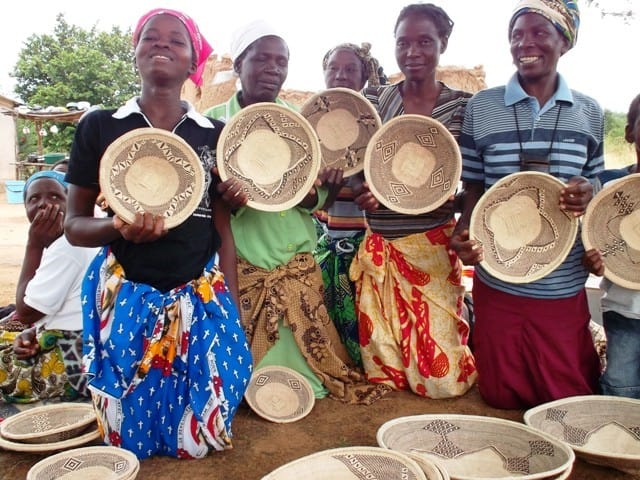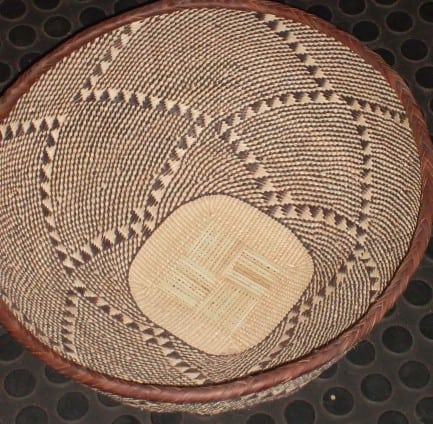- Tonga women producer group pose with their wall baskets
Zimbabwe is a landlocked country that sits in the southern part of Africa, flanked by Mozambique in the east and northeast, Zambia and Botswana in the west and South Africa in the south. Most of the country consists of a high plateau, of which the central region is dotted with hills and granite rocky outcrops and the eastern part consists of high mountain ranges called the Eastern Highlands. English is the official language of Zimbabwe, but most Zimbabweans are native speakers of Bantu languages, especially Shona, spoken by 76% of the population, and Ndebele, spoken by 18%. The majority of the productive sector being self-employed and an estimated one million people are said to be benefiting directly or indirectly from crafts marketing.
Traditional Zimbabwean crafts are famed and include pottery, basket making, textiles, jewelry and carving. Symmetrically patterned woven baskets and stools carved from a single piece of wood are especially good examples of Zimbabwean craftsmen’s skill. Shona sculpture, an attempt to apply European artistic training to the depiction of African folklore, has developed over the past few decades. Some Zimbabwean sculptors are counted among the world’s best.
It was in the late 19th century that the peoples of this area speaking several mutually intelligible languages were united under the Shona name. Although known for their stone sculpture, the Shona tribe of Zimbabwe has a rich artistic heritage, which includes decorative fabric painting using sadza. Sadza (pronounced sudza) is maize, a primary basis of their diet. Maize (corn) is ground into a fine meal, which is then cooked with water until it is the consistency of mashed potato. Although eaten plain, sadza is often served with a vegetable or meat sauce to give it flavor. This painting technique uses the sadza instead of wax as a masking between the different paint colors. After painting, the canvas is left to dry in the sun. Finally, the fabric is washed to remove the sadza, leaving it with a unique finished appearance. Designs often use traditional geometric patterns mixed with stylized objects from everyday Shona life.
Shona artists are well known for their stone sculptures. The stone carving has been part of the Zimbabwean culture since 1200 AD when Great Zimbabwe was built. With the re-emergence of this stone carving tradition in the 1950s, the stone has been used to express an extraordinary emotional power.
The Shona sculptures are produced from a variety of stones. Serpentine stone, with its considerable range of colors and hardness, is the material most commonly used by the sculptors. Formed over 2.6 billion years ago, serpentine stone exists in a diversity of colors including black (the hardest and least common), browns, mauves, greens, and yellows. Sometimes sculptures are also made semi-precious stones like “Leopard Rock” and verdite.
Baskets from Zimbabwe
Binga is one of Zimbabwe’s basket weaving communities located in the remote Binga district – home to the displaced baTonga people. The popular Tonga baskets have found an international market in art and design which brings in much-needed revenue. The range of baskets with designs inspired by nature depict the cultural values of the weavers. Learned during family apprenticeship, the basket weaving techniques have enabled quite a lot of rural women to send their children to school. Some regions that have also produced good baskets are Hwange, Matabeleland, Masvingo and Harare. Baskets are used for wall decorative, winnowing and table serving. All the baskets are made from natural raw materials
Today, many Tonga women utilize traditional weaving techniques to create intricately patterned baskets. All natural and locally harvested materials – such as wild grasses, small vines, and palm leaves dyed with tree bark – make up the baskets. The largest sized bowls are still used by the baTonga people for their original purpose of winnowing grains. Binga baskets are woven using the over and under style of ‘simple’ weaving and a 16-inch diameter basket can take around three days to complete. The baskets are finished using a coiled rim with a distinctive herringbone pattern.
Tonga women producer group pose with their wall baskets
The National Handicraft Center is a government owned company which collects crafts from all over Zimbabwe and markets it to the world over. The company was established in 1989 and links various community groups to the market. The company is committed to the development of art and craft producers and the marketing of their wares locally, regionally and internationally. Particular interest is given to the development of rural women who produce 75 percent of the marketed handicrafts.
The producers take pride in the preservation of traditions, skills and values that have been passed down through generations and today are being shared with the rest of the world. The skills and craftsmanship are distinctly portrayed in basketry, pottery, ethnic jewelry, traditional musical instruments, wood and stone carvings, crochet work, appliqué, embroidery, and natural fiber mat weaving. These are distributed worldwide to exclusive gift shops, home décor, galleries, crafts wholesalers and collectors. Our desire is to grow the Zimbabwean market into a world class crafts market which can positively contribute to the mainstream economy. More information is made available on www.nhc.co.zw .
We asked Leah to say something personal about her own involvement in Zimbabwe crafts
My first encounter with the Zimbabwean Crafts was in 1999 when l joined one of the few fair trade companies as a group marketing manager. This exposed me a whole new world of crafts marketing through Fair Trade. What touched me a lot was the involvement of Fair Trade in dealing with the world’s poorest commonalities and fight against trade injustice. I have a soft spot for the underprivileged and so l used to enjoy working with such communities and strive to bring food to their tables through marketing of their wares.
Zimbabwe is pegged against some of the world’s struggling economies. I could have joined the bandwagon and exodus of professionals in search of greener pastures outside borders. But someone had to stay behind ensuring that those poor communities, who were looking up to people like me for that ray of hope, are not let down. l made a covenant that l would be there for them and continue to explore ways of bringing more income to their homes. As a marketer I do 90% crafts marketing especially to the Fair Trade market. l encourage the poorest communities to carry with confidence. l have been in this industry for sixteen years. I also do a lot of community development and capacity building project for the rural folk.
I am in the processes of registering an NGO (Bata rouko) meaning ‘hold my hand’ that addresses the needs of Zimbabwean crafters, especially women and youth, through economic empowerment. But the challenge has been on the funding side as l need finances to regularise operations. l find peace when l know that those poor communities have something to smile about. It pains my heart to see them being exploited, abused and economically starved. The world takes advantage of the poor and that does not make it right. We need some people that will come forward and are prepared to grab their hands and usher them into light. PEOPLE LIKE YOU AND I.
Author

Leah Mugwagwa lives in Harare, Zimbabwe. She possesses a degree in Marketing (BBA),Graduate Diploma in Marketing |(IMM),Group Diploma IN Marketing(LCCI) and currently studying for an MBA in Strategic Marketing. She is married to Nathan and a mother of two boys, born in Zimbabwe Harare in a family of eight being the seventh born and grew up in Harare currently stays in Harare ( the capital City of Zimbabwe). Leah is a dedicated Christian (deaconess) and currently sits on the church council and is actively involved in the compassion ministry that takes care of the underprivileged










Comments
Dear Leah
I have a customer looking for customised baskets. Would you please email me back as soon as possible so that we can discuss further on shapes and sizes.
Kind regards,
Peter Namupira
African Home Creative Homeware
41 Caledon Street. Cape Town South Africa
Telephone 0027214611700
Cellphone 0027833388078
Leah
Please contât me re purchasing a lot of bing tonga baskets
my email is hassia@bigpond.com
Hello Leah,
Great website. I’m interested in buying Binga basket can you please connect me to an online shop.
Thanks
email: musoni8866@yahoo.com
That’s great that basket weaving techniques have enabled quite a few rural women to send their children to school. I personally love the look of Tonga baskets and would like to own some in my home. It’s awesome that all of these baskets are made from natural raw materials. https://www.mbare.com/baskets/tonga
Hi Leah,
I am interested in buying binga/tonga baskets on a wholesale basis.
Hi Leah,
I am interested in buying tonga baskets on a wholesale basis for different sizes & colors.
please contact me on my email: anyahomeshop@gmail.com
Was interested in buying wholesale for my store. If you could email me back that would be great.Thank you.
Hi Leah,
Iam interested in buying your binga/Tonga baskets online.
Kindly get back to me.
Watsut +256772614035
Leah I want to know more about basketry. May you contact me on whatsapp on 0719449979.
Hie Leah,am intrested in buying Tonga baskets.please contact me via email or whtasApp +27678315242
Thus wonderful. Looking for a market for binga baskets. I’m a producer
Thus wonderful. Looking for a market for binga baskets. I’m a producer. Any one interested may contact me on 0773507334